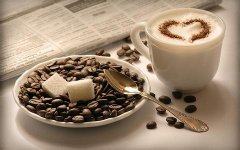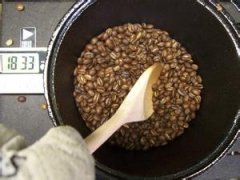Coffee roasting report the processing and roasting of coffee

Coffee processing Roasting:
When consigned coffee beans are traded on the market, the manufacturer who buys coffee beans should first boil the coffee beans into juice for tasting. After the transaction, the coffee beans are roasted according to the demand of the sales market. Roasting is one of the most important factors affecting the taste and flavor of coffee. Baking itself is both a science and an art. Green Coffee Bees undergo a complex series of changes during the roasting process of 8 to 20 minutes, with coffee beans gradually changing from light green to light yellow, light brown, brown, dark brown, and if roasted very deeply (as is the practice in southern Italy), finally turning into a shiny black brown. Coffee roasting is mainly divided into: City Roast(light roast), Full City Roast(medium roast), espresso Roast(deep roast), French Roast(heavy roast).
·Coffee processing:
After roasting coffee beans, in addition to single coffee beans, people will mix various single coffee beans according to their characteristics into a variety of different flavors of coffee beans in proportion to meet the needs of different tastes and different cooking methods.
·Coffee grinding:
According to different cooking methods, grind to the appropriate thickness.
·Coffee extraction or brewing:
Italian coffee is made by pressing ground coffee powder and then using espresso(Italian espresso) extracted by Italian coffee machine; coffee brewing is usually brewed by siphon coffee machine, mocha pot, American coffee machine, filter cup, filter pot, etc.
·Coffee transportation methods
Store in 60-70 kg bags, each bag has a shelf life of about one year (maximum temperature 35 ° C, relative humidity 75%) before shipment, generally by sea. The main ports of coffee transportation in the world are: New Orleans, Le Havre, Hamburg, Antwerp, Bremen, Genoa and Trieste.
Coffee inspection and selection
a. Depending on the characteristics of the coffee to be roasted:
b. You can choose different kinds of coffee. To ensure coffee quality, we only buy high-quality Arabica coffee beans. If the coffee beans purchased are of good quality, the roaster inspects them one by one to remove large, light and defective beans and remove impurities. Optical sorters or ultraviolet light can be used.
c. Then, the baker selects:
Ingredients: Decide which varieties of coffee beans to choose, where they come from, and the percentage of ingredients;
Baking time: Fast baking à Semi-fast baking à Slow baking;
Baking degree: early baking à medium baking à full baking;
Each roaster's coffee has its own characteristics, understandably: it all depends on his professional skills, experience, taste, imagination, and research spirit.
·Coffee re-check selection
Caffeine: Coffee beans contain caffeine is an alkali, allergies should not be ingested too much, caffeine is soluble in water, so one of the following methods can be used from raw coffee beans:
1. Water Solubility Method: A cylindrical extractor is used in which coffee beans are placed and treated with an aqueous extraction solution in which saturated amounts of the coffee dissolving agent, non-caffeine, are dissolved.
2. Ethyl acetate: Ethyl acetate is a solvent, also found in nature, used to wash green coffee and extract caffeine.
3. Methylene chloride: Methylene chloride is a chemical solvent that volatilizes naturally at temperatures above 40 ° C; it can be used to wash coffee and extract caffeine.
4. Carbon dioxide: Under critical conditions (gas/liquid, pressure =250 bar), caffeine can be extracted by washing coffee with carbon dioxide (CQ2), which acts as a solvent.
Coffee roasting knowledge
Important Notice :
前街咖啡 FrontStreet Coffee has moved to new addredd:
FrontStreet Coffee Address: 315,Donghua East Road,GuangZhou
Tel:020 38364473
- Prev

Roasted coffee beans baked in home ovens
The hardest part of coffee-related activities is baking coffee beans yourself. When it comes to making high-quality coffee, the freshness of coffee beans is the most important. We all have the experience of buying our own coffee beans from roasters, even once, which is not comparable to making coffee with our own roasted beans. So bake coffee beans in your own kitchen. It's worth a try.
- Next

Knowledge about coffee roasting can release the special aroma of coffee.
Through the burning of the fire, the special aroma of coffee can be released, sprinkling the personality of each coffee bean: sour, sweet and bitter, from the insipid raw bean to the endless aftertaste in the cup. Roasting-is the most important station for each coffee bean to outline its character and breed its fragrance during its long journey. The coffee beans are about 12-16 minutes long and warm.
Related
- Beginners will see the "Coffee pull flower" guide!
- What is the difference between ice blog purified milk and ordinary milk coffee?
- Why is the Philippines the largest producer of crops in Liberia?
- For coffee extraction, should the fine powder be retained?
- How does extracted espresso fill pressed powder? How much strength does it take to press the powder?
- How to make jasmine cold extract coffee? Is the jasmine + latte good?
- Will this little toy really make the coffee taste better? How does Lily Drip affect coffee extraction?
- Will the action of slapping the filter cup also affect coffee extraction?
- What's the difference between powder-to-water ratio and powder-to-liquid ratio?
- What is the Ethiopian local species? What does it have to do with Heirloom native species?

